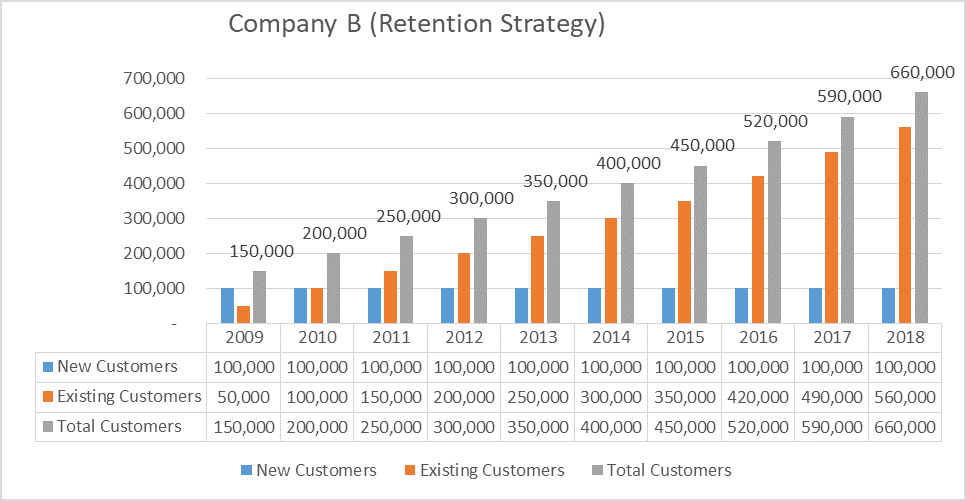To a large extent, it is cheaper retaining old customers than acquiring new customers. Nevertheless, most marketers prioritise acquisition of new customers over retention of old customers; in many cases, as consequence of marketing programs which are not data-driven.
In this article, I discuss the outcome of a scenario involving two retailers to illustrate why businesses need a data-driven marketing campaign.
Company A and B, operates a retail chain in the nation’s biggest shopping mall. Every year, company A attracts about 100,000 new customers, but has no strategy to retain existing customers. So I assume company A retains about 50% of new customers. Company B also attracts about 100,000 new customers every year and has no retention strategy until 2016 when it started a campaign to retain more customers. As a result, company B’s retention rate increased from 50% to 70%.
The total number of customers for company A and B from 2009 to 2018 are shown in the bar charts below. The third graph shows the growth rates in total number of customers.

company a

company b

growth rates
From 2010 to 2015, total customers for company A and B increased at the same rate. But from 2016 to 2018, total customers for company B increased at a higher rate than company B. Obviously, Company B’s campaign to retain more customers is paying off.
Another way to analyse the outcome of this scenario is to estimate the lost customer value as a result of low retention. Thus, without any retention strategy, each company misses the opportunity to add 50,000 more customers to its existing customer base. Assuming a customer spends GHȻ500 a year in either shop that translates to GHȻ25m loss in customer value.
Starting 2016, this no longer applies to Company B. Due to its marketing campaign, company B retains additional 20,000 customers. In monetary terms, that’s additional revenue of GHȻ 10m (20,000 * 500), effectively cutting down the lost customer value from GHȻ 25m to GHȻ 15m.
Any way you look at it, retaining customers pay over time. It reduces customer churn; it maximises customer lifetime value. The question is how do you plan and execute effective retention campaigns?
First of all, you have to determine which customers to retain. Not all customers have equal lifetime value. There are high-value customers, medium-value customers, and low-value customers. Often, high-value customers and medium-value customers account for more than 90% of your revenue. Hence, you should invest more in returning high-value customers and medium-value customers. The only way to do this is actively collect data and apply marketing analytics to group customers into value segments.
Finally, you have to prepare a budget for retaining customers. The objective here is to optimise your retention budget such that you do not spend more than the customer value. Thus, for every next or subsequent purchase, you compare the gross margin per order to the marketing cost generating the order. You do this for each retention strategy included in the budget in order to select a strategy mix that maximises customer value. To do this, you will need customer level transaction data and marketing cost data.
Few decades ago, data-driven marketing campaigns seemed elusive. Now, advances in cloud computing, data warehousing, and big data analytics are enabling data-driven campaigns. It is less expensive to deploy analytics platforms to execute data-driven campaigns. Depending on your need, there are several solutions to explore. You can do it yourself (build the platform to collect and analyse customer data), outsource data-driven campaigns to marketing service providers, or buy off-the-shelve platforms from software vendors.
Whichever solution you deploy, the point of this article is get you started as soon as possible.
Elvis Agbenyega is the Country Director of Wave-2 Analytics. He combines his domain knowledge in business administration with data analytics to help businesses of all sizes deploy machine learning to understand their customers better and offer them personalised experiences leading to increased customer loyalty and revenue.